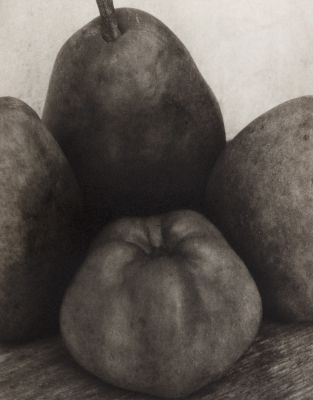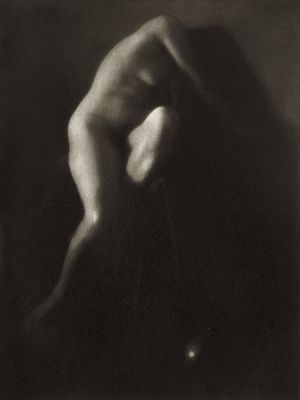
Title
The FlatironArtist
Steichen, Edward (American, 1879-1973)Publication
Early Years Portfolio, 1900-1927Date
1980 plate (1905 negative)Process
PhotogravureAtelier
Jon Goodman Photogravure, MassachusettsImage Size
13 x 10.25 inSheet Size
20 x 16 in
…a dramatic representation of that moment at dusk when the sky turns a leaden blue-green and highlights glow in the half-light There is no clearer example of an early modernist photographic composition, one that combines contemporary Pictorial expression in art alive with the gestures of living in New York just as it becomes a vital, international metropolis. [1]
Edward Steichen was one of the most prominent and influential figures of twentieth-century photography. His richest, most profound photographs were made between 1900 and 1927. It is from this period that Steichen selected his masterpieces and asked Aperture to publish his prints as hand-pulled photogravures. At the time, the photogravure process had been essentially dormant since the second world war. Fortunately for Steichen and Aperture, Jon Goodman was well on his way to resurrecting it.
Here is the story in Jon’s words recounted in 2018…
The Steichen Portfolio was my first big project in photogravure. I started work on it in 1979 (I was 25). But it was a project that predated me. I was told that it was a project that Edward Steichen and Alfred Stieglitz had discussed while both were alive. In 1967 when Paul Strand’s “Mexican Portfolio” was re-editioned by Da Capo press in conjunction with a nascent Aperture (printed by Andersen Lamb printing co of Brooklyn from plates made in 1939 by the Photogravure and Color Co) Edward Steichen approached Michael Hoffman of Aperture about doing his project. Sometime around then, Steichen’s printer from New York (name unknown to me) returned to his native Munich. There he found a printing/engraving company that still practiced dust grain photogravure. They made an initial plate of “Steichen and his Sister” or “After the Races” which was of good quality. Subsequently they made other plates and prints that they would send to Michael Hoffman in New York that were less good. There was some difficulty with communicating the print quality that was needed between language difficulties and some lack of awareness of the photographic quality that was needed from the photogravures. The project then languished until in the spring of 1978 when I had contacted Michael Hoffman as one of the people who might be potentially interested in the work that I had been doing on my Independent study researching and practicing dust grain photogravure. My research was funded with a Fellowship from the Thomas J. Watson Foundation as a postgraduate year of independent study abroad which I had begun upon graduating from Antioch College in 1976. I met with Michael Hoffman in New York in June of 1978 and showed him the work that I had been doing on my research which had primarily been done in Switzerland, first at the Centre Genevoise de Gravure Contemporaine and later at the Atelier de Taille Douce et Lithographie of St. Prex. He was quite interested and spoke to me about a couple of projects, but primarily about the Steichen Portfolio which had been languishing for a few years. Michael Hoffman called Richard Benson in Newport and arranged for me to go and meet with him at his home and studio. Benson had most of the equipment and facility needed to work in photogravure in his shop in Newport. He had an intaglio press that had been purchased with funds provided by Georgia O’Keefe to make photogravures of Stieglitz’s work. I met with Benson and we arranged that I could come and work in his shop in the fall of 1978 on some of Aperture’s potential photogravure projects. I returned to Newport in September of 1978 with the purpose of making some initial plates of Paul Strand’s work. I had access to Strand’s negatives through his association with Aperture, and Benson had been Strand’s printer at the end of Strand’s life and knew what the images should look like. There was no funding for this work initially. It was thought that I would come to Newport for a few weeks but that turned into 3 years. The initial Strand plates (“Gaspe’ Fisherman” and “Iris, Maine”) were a struggle. It was one thing for me to take one of my own negatives and make a photogravure plate and print but it was a whole other order of magnitude to take a negative of Paul Strand’s and make a photogravure plate and subsequent print that had a visual equivalency to Strand’s own print from that negative. The Gaspe’ Fisherman was made and editioned for the end of 1978 early 1979.
Once it was established that I was able to make photogravures worthy of Paul Strand’s work and comparable to the photogravures from the Mexican Portfolio, it was decided that we could proceed with the making of the Steichen Portfolio. In the winter of 1979, I was sent to Munich to retrieve the material that had been provided to the printers there (Steichen’s printer had passed away by then). I had with me the “Iris” plate that I had made that fall in collaboration with Richard Benson. I asked the printers in Munich to make some proofs of that plate to take back to New York. I then went on to St. Prex Switzerland where I shared the work that I had been doing with my friends at the Atelier de Taille Douce and asked them to also proof the “Iris” plate in their manner of working. I then took both sets of proofs of the “Iris” back to New York to show to Michael Hoffman. The difference in quality between the proofs made at the Atelier de Taille Douce and those from Munich was quite striking. There is a smoothness and a freshness to the photographic tones in the Atelier proofs while the Munich proofs were cottony and muddy. It was decided that the Atelier should edition the “Iris” plate while I went on to the making of the plates for the Steichen Portfolio. The only funding that was available was some occasional money furnished to Aperture by Hazel Strand to keep me going. It was not until I made the plate for the Heavy Roses and showed those proofs to Michael Hoffman that I began to be paid on any regular basis. I was 26 or 27 at the time and had minimal responsibilities and was very committed to the work that I was doing. Indeed, I was in effect pursuing what I thought was my calling of reviving this most beautiful printing process of photogravure. Could there have been better projects for me to begin that work with than that of Paul Strand and Edward Steichen?
It took me a full 12 months to make the 12 plates that are in the Steichen Portfolio. Multiple plates were made for each image before a satisfactory plate was accomplished. Then multiple proofs were made for each image, in different inks, varying both the transparency and the ink color for each. In the end after a great deal of deliberation we established the “bon a tirer” for each plate, which I then took back to the Atelier de Taille Douce in St. Prex. We began printing the 12 plates in the spring of 1980, it took another 12 months to print all the plates in the initial printing of 500 copies. A specific ink was made for each plate and to achieve the 550 prints needed (500 edition + 50 Artist Proofs) 600 actual prints were pulled. After printing each of the prints (except the Heavy Roses) were then spray lacquered with a lacquer that I had developed to increase the richness of the prints and the gloss. This was a look that Strand had pioneered with the Mexican Portfolio and Michael Hoffman insisted upon this extra step for all but the Heavy Roses. The entire edition was listed as 1000 +100 A.P.’s. It was 20 years before the second half of the printing was needed, that was done in the early 2000’s. For quite a few of the images in the Steichen portfolio original negatives were not to be found. “In Memoriam” was made from a print that was owned by Andre Jammes that he had located in France in an estate sale. It was rumored that it had been in the family of the model. “Moonrise, Mamaroneck”, “The Flat Iron” and “Richard Strauss” are from the Stieglitz Collection at the MET. Richard Benson and I made multi piece, full size copy negatives of the original Gum over Platinum prints on a horizontal process camera that had been in the basement of the MET at the time.
Reproduced / Exhibited
Frizot, Michael. New History of Photography. Place of publication not identified: Pajerski, 1999. Print
Malcolm R. Daniel, and Florian Rodari. Graver La Lumière: L’héliogravure D’alfred Stieglitz À Nos Jours Ou La Reconquête D’un Instrument Perdu. Vevey, Suisse: Fondation William Cuendet & Atelier de Saint-Prex, 2002. p. 26
References
[1] Frizot, Michael. New History of Photography. Place of publication not identified: Pajerski, 1999.p. 318










